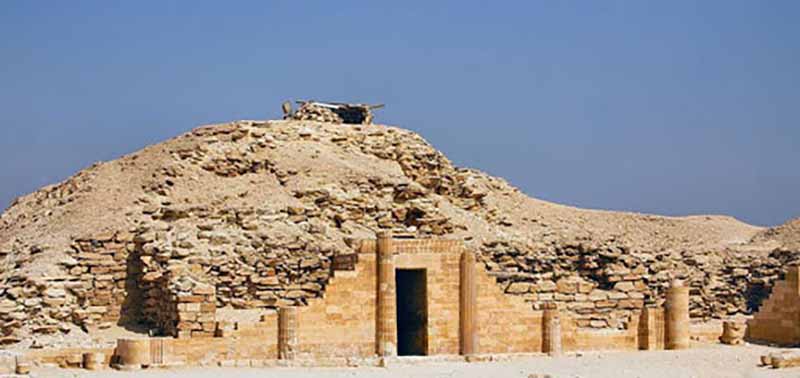
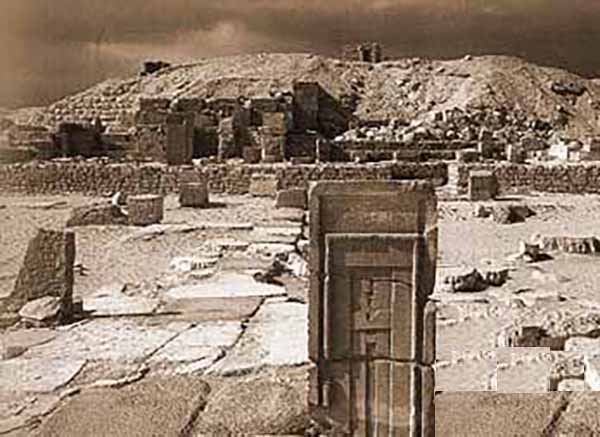


The Pyramid of Pepi I (in ancient Egyptian Men-nefer-Pepi meaning Pepi's splendor is enduring) is the pyramid complex built for the Egyptian pharaoh Pepi I of the 6th Dynasty in the 24th or 23rd century BC. The complex gave its name to the capital city of Egypt, Memphis. As in the pyramids of his predecessors, Pepi I's substructure was filled with vertical columns of hieroglyphic texts, Pyramid Texts. It was in Pepi I's pyramid that these texts were initially discovered in 1880 by Gaston Maspero, though they originated in the Pyramid of Unas. The corpus of Pepi I's texts is also the largest from the Old Kingdom, comprising 2,263 columns and lines of hieroglyphs.
Pepi I sited his pyramid complex in South Saqqara an approximate 2.4 km (1.5 mi) north of Djedkare Isesi's pyramid. It is unclear why Pepi I relocated to South Saqqara. Perhaps Pepi I had moved the royal palace south and away from the city, or perhaps no viable sites were left in North and Central Saqqara after Teti built his pyramid there. Pepi I entrusted one of his wives, Inenek-Inti, with the construction of the funerary monument.
The pyramid and substructure replicated the basic design of Djedkare-Isesi's and is proportionally very similar. The pyramid has been extensively damaged and now stands as a small ruinous mound. The mortuary temple has also seen extensive damage from stone thieves, but the work carried out by the Mission archeologique franćaise de Saqqara/Mission archeologique franco-suisse de Saqqara (MAFS) has revealed that the temple is laid out in near exactly the same manner as those of his predecessors. Excavation work at the causeway has only extended out to a few metres, and the valley temple and pyramid town remain unexcavated.
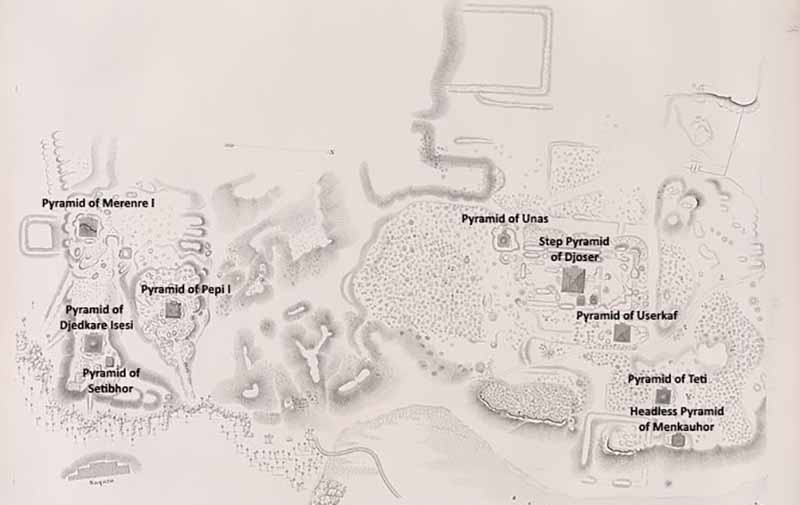
Pepi I selected a site about 2.4 km (1.5 mi) north of Djedkare's pyramid in South Saqqara. Mark Lehner suggests that siting the pyramid in North or Central Saqqara may not have been possible after Teti built his pyramid there, and that this may be the reason for Pepi I's choice to move to South Saqqara.
The pyramid was first examined by John Shae Perring in the 1830s. In 1880, Gaston Maspero, director of the French Institute for Oriental Archaeology in Cairo, arrived in Egypt. He selected a site in South Saqqara, a mound that had been previously mapped by Karl Richard Lepsius, for his first archaeological dig. Here he found the ruins of a large structure which he identified as the pyramid of Pepi I. During the excavations he was able to gain access to the substructure where he discovered that the walls were covered in hieroglyphic text – the Pyramid Texts. This was the first pyramid in which texts were found. Maspero also found texts in the pyramids of Unas, Teti, Merenre I, and Pepi II in 1880-1. He published his findings in Les inscriptions des pyramides de Saqqarah in 1894.
The south face and wall and a section of the east face of the pyramid were excavated between March and April 1996. A wealth of inscribed limestone blocks were also uncovered. They bear the names of individuals involved with the construction of the complex, and their recovery is significant because they would typically be hidden by the encasement.
From these inscriptions it was worked out that family members of the pharaoh were involved in the project. Teti-ankh, a son of Teti according to Vassil Dobrev, managed various activities around the complex. His name is particularly associated with the enclosure wall and measurement taking. Inenek-Inti, a wife of Pepi I, appears on multiple blocks inscribed with titles indicating her role as the architect and builder of the monument. More inscribed limestone blocks were uncovered in the period between February and April 1997. Over the course of the years 1995 to 1997, all four sides of the pyramid were cleared, and hundreds of blocks recording the involvement of about forty individuals discovered.
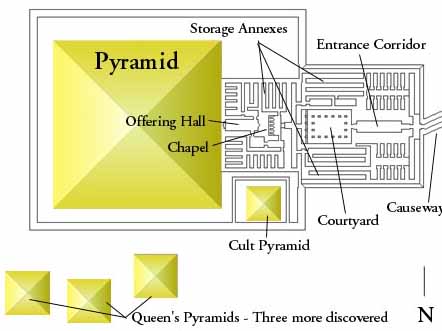
Old Kingdom mortuary complexes consisted of five essential components: (1) a valley temple; (2) a causeway; (3) a pyramid, or mortuary, temple; (4) a cult, or satellite, pyramid; and (5) the main pyramid. Pepi I's complex comprises: a main pyramid constructed of six steps of limestone encased in fine white limestone; a mortuary temple that near exactly replicates those of his predecessors, with a cult pyramid to its south; and a valley temple and causeway that have not been excavated. The name of Pepi I's pyramid complex, Men-nefer-Pepi, was adopted as the name of the capital city of Egypt, Men-nefer (Memphis)

While stone thieves seriously damaged the complex, important discovered were nevertheless made. These included limestone statues of kneeling enemies of Egypt with their hands tied behind their backs. They once stood in the open courtyard, and may also adorned the entrance corridor. These types of statues have been found in several pyramids and perhaps had the function of frightening away anyone who might wish to damage the structure. They symbolized conquered evil. On the foundation of the pyramid was also found a small cult pyramid.
Pepi I's pyramid has a core of six steps and was constructed in much the same way as Djedkare's pyramid, which used small blocks of limestone bound with a clay mortar. Interestingly, blocks from Teti's mother, queen Sesheshet, were discovered within the core of this pyramid. This was Pepi's grandmother, and may have been removed from a destroyed building. The pyramid was, as usual, cased with fine white limestone, though it remains intact only at the lowest levels.
The pyramid's entrance is in its courtyard pavement next to its north face. There was probably a chapel here, but nothing of it remains today. The subterranean levels are similar to earlier pyramids of the 5th and 6th Dynasties, beginning with a descending limestone corridor that that leads to a vestibule. After the vestibule, the next corridor is level but is reinforced at three places with pink granite. Located about in the middle of this second corridor is the barrier made of three portcullis blocks also of pink granite. This corridor leads to an antechamber on the pyramid's vertical axis. West of the antechamber is the burial chamber, and to its east is a serdab with three niches.
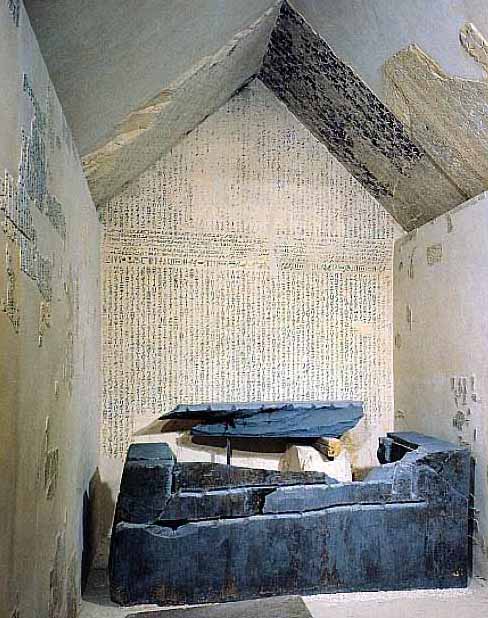
The gabled ceilings of the antechamber and burial chamber consists of three layers of blocks, each layer having sixteen blocks. All together, these ceilings weighed some five thousand tons. The ceiling is astronomical, but with white stars on a black background.
Some burial equipment was found within the pyramid. fragments of a sarcophagus that stood on the west wall of the burial chamber suggest that it was probably a substitute, the original having broken in transportation or perhaps developed flaws. A fragment of a mummy was found that could have been that of Pepi I, but is uncertain, along with some fine linen wrappings. Fourteen shards of yellow alabaster canopic vessels were discovered, together with a small flint knife, a piece of pleated linen and a left sandal of reddish wood, possibly made of sycamore.
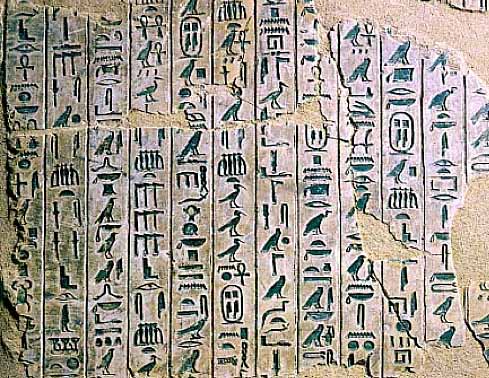
Pyramid Texts not only cover the walls of the antechamber and burial chamber, but also the corridors. Some of these texts remain in place, while others parts are in fragments (about three thousand fragments). In piecing this all together, the French team has discovered that about two thirds of the inscriptions were altered by reducing the size of the glyphs.
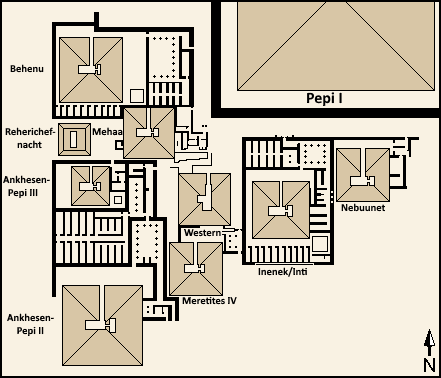
The most significant finds at Pepi I's complex are the Queens' Pyramids. As of 2018, a total of nine pyramids have been discovered in an area to the south-west of Pepi I's pyramid. These pyramids belong to: Nebuunet, Inenek-Inti, Meritites IV, Ankhesenpepi II and Ankhesenpepi III, Mehaa with a tomb belonging to her son Hornetjerikhet to its north, Behenu, Reherichefnakht and one anonymous.
Pyramid of Nebuunet
Nebuunet was a wife of Pepi I, buried in a pyramid adjacent to his. The complex is the easternmost one so far discovered, and contains a ruined pyramid and small mortuary temple. The pyramid, constructed from limestone, had a base length of about 20.96 m (68.8 ft; 40.00 cu) and a peak height of 21 m (69 ft; 40 cu). Its entrance is set into the pavement of the north chapel and leads into a descending corridor. This transitions into a horizontal passage through a faux vestibule. A single granite portcullis guarded the burial chamber, which was located south of the pyramid's vertical axis. The substructure has the same lay-out as Inenek-Inti's pyramid, with the distinction that her sarcophagus was made of pink granite, rather than greywacke. East of the burial chamber was the serdab which contained fragments of funerary equipment including a cylindrical wooden weight and wooden ostrich feather, potentially representing the feathers of Maat.
The complex is entered through a limestone door facing Pepi I's pyramid. The door has near wholly been reassembled from rediscovered components. Each doorjamb has a complete image of the queen depicting her as a slender woman, wearing a wig that frames her face, equipped with a scabbard and a large necklace dangling around her neck.
In one hand she holds a lotus flower breathing in its scent, while the other hangs behind her. Her name and title are inscribed on the doorjambs: "the wife of the king, his beloved, Nebuunet". On the upper part of the jamb, beneath the hieroglyph for sky, a royal falcon with spread wings clutches an ankh pointed at a cartouche bearing Pepi I's name, itself part of a unit of three columns of text.
The limestone door of the complex leads into an antechamber from which the courtyard surrounding the pyramid, and a small mortuary temple of the east face of the pyramid, could be accessed. The temple is in complete ruins, except for the offering hall and a section of wall about 1 m (3.3 ft) thick, which have been better preserved. North of the offering hall was a chapel with three niches. Inside the hall, fragments of sculptures depict the queen on a podium with lions facing a goddess holding a was scepter and the ankh sign. Very little of the relief decoration of the temple has been preserved.
Inenek-Inti was a wife and vizier of Pepi I, buried in a pyramid adjacent to his. The pyramid had a base length of 21 m (69 ft; 40 cu), converging towards the apex at ratio of 1:2 to a peak height of 21 m (69 ft; 40 cu). The base area of Inenek-Inti's pyramid is thus 1/14th that of Pepi I's pyramid, and its volume 1/10th. In contrast, both her pyramid and its mortuary temple are larger than that belonging to Nebuunet to the east. Inenek-Inti's pyramid is enclosed by a perimeter wall 1.5 m (4.9 ft) thick.
Entrance into the pyramid is gained at a small entrance chapel on its north face. The entry leads into a short descending passage which terminates at a vestibule opening onto the main corridor. The corridor, guarded by a single granite portcullis, leads towards the burial chamberunder the pyramid's vertical axis. To the east of the burial chamber is a serdab. On the west side of the burial chamber is a greywacke sarcophagus. The chamber is in ruins, and only fragments of funerary equipment have been preserved: pieces of stone hardware in various colors, and containers with limestone covers meant to protect funerary provisions.
The mortuary temple of the complex is cramped and spreads along the north, east and south sides of the pyramid. Two granite pillars facing north towards the king's pyramid serve as the door into the temple. The pillars are engraved with Inenek-Inti's name, and the queen depicted seated, breathing in the scent of a lotus flower. Two obelisks of gray limestone are present here which depict the queen standing. These too are engraved with her name, one with Inenek and one with Inti. They also bear her titles. The outer temple consists of a hall and a pillared courtyard in the north-east. South of the courtyard, on the east face, were the offering hall and a room containing three statue niches.] A group of storerooms flanked these to the north and south. In the south-east corner, was a small cult pyramid. The cult pyramid had a base length of 6 m (20 ft; 11 cu).
The identity of this pyramid's owner is preserved on an obelisk in front of her pyramid only as "the eldest daughter of the king". This was the first Queen's pyramid unearthed by MAFS in 1988. The pyramid had a base length of around 20 m (66 ft; 38 cu), the same as Nebuunet's, but the ruins stand a paltry 3 m (9.8 ft; 5.7 cu) tall. Entry into the substructure is gained on the north face. The burial chamber is located under the vertical axis of the pyramid. The location of the serdab is unusual, being to the south of the burial chamber instead of east. Substantial remains of funerary equipment were found inside, but no name:wooden weights and ostrich feathers, copper fish hooks, and fired-clay vessels. It has a hastily built mortuary temple, with an offering hall and a room with two statue niches. Relief fragments discovered depict scenes of processions and estates, along with an incomplete cartouche of Pepi I's name.
Meritites IV was a wife of Pepi I, or Pepi II. Her pyramid lies to the south of the anonymous "Western pyramid". It has a base length of 21 m (69 ft; 40 cu) and its substructure is decorated with the titulary of the queen painted halfway up the chamber walls. During the excavation, wood fragments, likely from a box or canopic chest, were discovered with formulas from the Pyramid Texts painted on them. Her identity, image and titles were recorded on in a courtyard with five pillars. In 2007, the pyramid of Meretites IV had been completely restored and a greywacke monolith pyramid replaced. The complex is accessed from the north-east via a long corridor linked off the street which leads into the courtyard. West of the courtyard is the north side of the pyramid. South of the courtyard is the inner temple. Her complex is surrounded by the pyramids of Ankhesenpepi II to the west, Inenek-Inti to the east, and the Western pyramid to the north.
Ankhesenpepi II was a wife of Pepi I and mother to Pepi II. Her pyramid lies south-west of Meritites IV's pyramid, at the south-western corner of the complex. With a base length of 31.4 m (103 ft; 59.9 cu), it is the largest pyramid in the complex after the pyramid of Pepi I. The outer, or public, mortuary temple was built on a north-south axis. To the west are a series of twenty-one storerooms arranged in a tooth-comb fashion, and to the south is a large courtyard with two doors. The south-east door leads to the inner, or private, template. The south-west door leads to the north face of the pyramid.
On the north face of the pyramid, remnants of a 4.2 metres (14 ft; 8.0 cu) wide north chapel were found. The substructure to the pyramid was discovered filled with sand and debris, but once cleared revealed a large 7.34 m (24.1 ft; 14.01 cu) (east-west) by 3.15 m (10.3 ft; 6.01 cu) (north-south) burial chamber. To the east was an uninscribed serdab. The burial chamber of Akhesenpepi II's pyramid contains a massive, carefully dressed basalt sarcophagus. The body of the sarcophagus is 2.84 m (9.3 ft) long by 1.27 m (4.2 ft) wide. It had a lid, found fragmented into four pieces, that appears to have been made from a different material to the sarcophagus body. The queen's titulary appear on the sarcophagus and lid identifying her as the mother of the king, and daughter of Geb and Nut.Bone fragments of the arm, leg and foot were recovered during evacuation of the sarcophagus. These were identified as belonging to a mature adult female with osteoarthritis. The walls of the substructure contain Pyramid Texts.
In the mortuary temple of Ankhesenpepi II's funerary monument, a decorative block bearing the cartouches of Pepi I, Pepi II and Merenre I was discovered in 1998. The first two cartouches were easily explained: Pepi I was the husband of Ankhesenpepi II, and Pepi II was her son. The third, that of Mererenre I, remained unexplained until a damaged second decorative block was found in the pillared courtyard a year later. It bore the titles of Queen Ankhesenpepi II and identified her as the wife of Merenre I. According to Labrousse, Ankhesenpepi II remarried to Merenre I, her nephew, after the death of Pepi I.
Ankhesenpepi III was a daughter of Merenre I Nemtyemsaf and a wife of Pepi II. Her pyramid is located north of Ankhesenpepi II's pyramid, and south-west of Mehaa's. Her pyramid complex is the smallest in Pepi I's greater complex. Its size constrained by the boundary of the complex to the west, Ankhesenpepi II's mortuary temple to the south and east, and an esplanade to the north that likely contained worship facilities. The pyramid has a base length of 15.72 m (51.6 ft; 30.00 cu). The complex is entered at the north-east corner of the north wall and is preceded by two obelisks. On the east face of the pyramid is the mortuary temple which has been reduced to an intimate temple consisting of two rooms leading to the offering hall. South-east of the pyramid is a small courtyard which hosts a cult pyramid in its center. Fragments of a decree from Pepi II honoring Ankhesenpepi III were found north of the complex's enclosure wall.
The burial chamber of the pyramid is badly damaged. It contains a sarcophagus made from a single sandstone block buried in the floor, with a lid of roughly cut granite. The walls around the sarcophagus have been painted to represent the royal palace facade. The sarcophagus is inscribed with Ankhesenpepi III's name and titles, and contained bone fragments.
In the western part of the funerary complex, a mudbrick superstructure was uncovered. A shaft by the structure led to a vaulted chamber, through which a decorated limestone burial chamber could be accessed. The burial appears to date to the First Intermediate Period.The owner of the burial is Ankhnes, a priestess of Hathor of Ankhesenpepi III. Alongside the burial, a 38 cm (15 in) decorative wooden statuette of the subject and five decorated wooden mirror handles were recovered.
Mehaa was a wife of Pepi I. She was buried in a pyramid at the end of "Queen's street" (French: rue de reines). Before the pyramid is a building, which bears the name and image of Prince Hornetjerikhet, a son of Pepi I.
Behenu was a wife of Pepi I or Pepi II. In 2007, the remains of her pyramid were uncovered. The pyramid is located at the western end of the complex, directly north of Mehaa's pyramid. It has a base length of 26.2 m (86 ft; 50.0 cu), making it the second-largest Queens' pyramid in the necropolis after that of Ankhesenpepy II. Fragments found in the mortuary temple identified the owner, Behenu. The name matches fragments of Pyramid Texts previously found around the tomb of Reherichefnakht. These fragments must have originated from the chambers of her pyramid. The walls surrounding the sarcophagus in the burial chamber were adorned with a black and red painted rendition of the royal palace facade and text inscribed above. Fragments of green paint have been retained on some of the inscribed hieroglyphs, with black and red painted lines separating vertical registers.
The enclosure to the complex is entered near the north-east corner off a north-south street. The doorway leads into a vestibule with a door to the courtyard in its north-western corner. The courtyard has two doorways. The first, in the south-east leads to a vestibule with two connecting rooms. To the north is a long windowless vestibule. To the west are a series of ten store-rooms. A second door in the north-west of the courtyard leads into the inner, or private, temple. Here a series of rooms can be accessed from a north-south running passage including: a windowless room, the statue chapel and the offering hall. At the south-east corner of the pyramid is a small courtyard with a cult pyramid at its center. The cult pyramid has a base length of 5.5 m (18 ft; 10.5 cu).
In the debris of the temple, which bore marks of destruction and restoration, a preserved statuette head of Behenu wearing a wig and with in-laid eyes was found. An offering table discovered in the vicinity of Behenu's monument has identified a daughter of Behenu named Hapi.
In 2004, a pyramid belonging to an individual named Reherichefnakht was discovered in the complex of Pepi I's pyramid. The pyramid likely dates to the end of the Eleventh Dynasty, and is thus the oldest known pyramid not built for a member of the royal family. It has a base length of 13.12 m (43.0 ft; 25.04 cu) made from limestone blocks presumably scavenged from nearby structures. Remnants of stelae, offering tables, door stops and lintel, many of which bear names were found in the core of the pyramid. One significant find is the name of a previously unknown wife of Pepi I, Sebutet. The pyramid substructure contains both Pyramid Texts and Coffin Texts, thus representing a link between the Old Kingdom and Middle Kingdom of Egypt. The substructure has a simple design: from the north, a shaft leads to the burial chamber covered with stone slabs, one of which bears Reherichefnakht's name. The chamber was richly decorated, and contained Pyramid Texts 214–217 and Coffin Text 335. No other buildings associated with pyramid complexes were built, and no burial for a wife of Reherichefnakht was found.
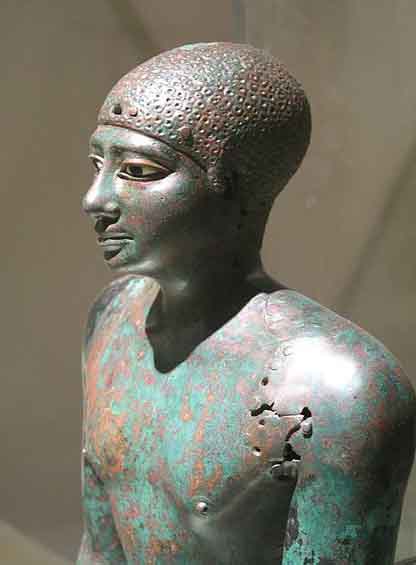
Pepi I